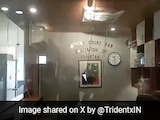Sonic booms and shockwaves have been significant barriers to the development of supersonic aircraft, causing concerns about noise, damage, and safety. However, researchers from Northwestern Polytechnical University in China have made a groundbreaking discovery to mitigate these effects. According to the South China Morning Post, scientists drilled holes in the plane's wing and found a way to reduce the intensity of sonic booms.
The researchers' unconventional method of drilling holes in the wing yielded two major benefits:
- Reduced sonic booms: By allowing airflow to pass from the underside to the top surface, the holes effectively mitigated shock wave vibrations, decreasing the intensity of sonic booms.
- Improved aerodynamic efficiency: The holes increased aerodynamic efficiency by over 10%, as reported in the study published in Acta Aerodynamica Sinica.
How will this work?
According to Bernoulli's principle, the curved upper surface and flat underside of an aeroplane wing create pressure differences, generating lift. However, as planes approach the speed of sound, shock waves form, causing turbulence and destructive vibrations. Only a few specially designed planes can overcome this barrier. Sonic booms produced by shock waves can be explosive and shatter windows.
So, researchers at Northwestern Polytechnical University, led by Professor Gao Chao, proposed a solution: adding holes to the wing. When the plane surpasses the speed of sound, a cover opens, allowing airflow to converge and prevent shock waves. An air pump modulates the jet stream, halting turbulence and nearly eliminating wing vibrations. This innovative design could resolve the issues associated with supersonic flight, making it more accessible and efficient.
''When using jet stream control to suppress shock wave buffeting, although there is a slight loss of lift, it can reduce overall drag, so the lift-to-drag ratio increases rather than decreases,'' Mr Chao and his colleagues wrote.
Researchers, mainly from China and the US, have explored various methods to reduce supersonic flight turbulence and noise. These include adding grooves or protrusions to the wing surface, installing mechanical devices to suppress shock waves and Using piezoelectric film coatings to manipulate airflow
Meanwhile, NASA's X-59 supersonic jet which aims to reduce noise is set for its first test flight this year. However, Mr Gao's team believes their solution is the simplest and most effective. They plan to conduct further wind tunnel tests to develop their technology for practical application.















